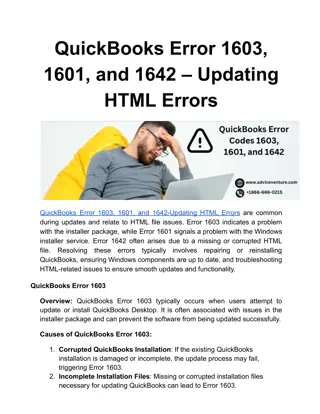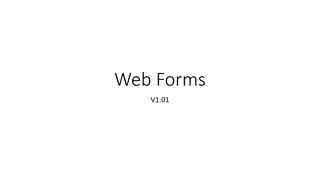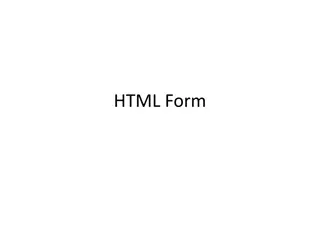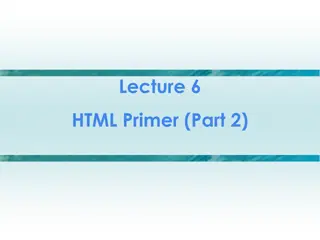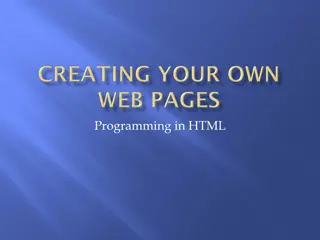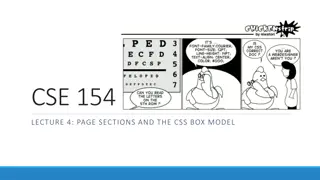Understanding HTML/CSS: Basics and Origins
HTML (HyperText Markup Language) and CSS (Cascading Style Sheets) are fundamental programming languages used in web development. HTML provides the structure of a website, while CSS is used for formatting and styling. This article delves into the origins of HTML, its evolution, the basics of HTML and
3 views • 24 slides
Understanding CSS in Amity School of Engineering & Technology
CSS, or Cascading Style Sheets, plays a crucial role in web development by specifying how documents are presented to users. This lecture series from Amity School of Engineering & Technology covers the basics of CSS, including its relationship with HTML, how browsers interpret CSS rules to style web
6 views • 39 slides
Understanding the Periodic Table and Chemical Bonds in Physical Science
The periodic table organizes elements based on their properties, with rows representing periods and columns representing groups. Mendeleev's early table laid the foundation for predicting undiscovered elements. Today's periodic table orders elements by atomic number, showcasing the periodic law and
3 views • 15 slides
QuickBooks Error 1603, 1601, and 1642 – Updating HTML Errors
QuickBooks Error 1603, 1601, and 1642-Updating HTML Errors are common during updates and relate to HTML file issues. Error 1603 indicates a problem with the installer package, while Error 1601 signals a problem with the Windows installer service.
2 views • 5 slides
Creating Interactive Web Forms Using HTML and CSS Styling
Explore how to design interactive web forms with HTML for user input fields and CSS styling for enhanced visual appeal. Learn about interesting properties that can be applied to input boxes, such as placeholders, readonly, checked, maxlength, size, and required attributes. Discover how to create sel
1 views • 27 slides
Understanding HTML Forms and Form Controls
HTML forms are essential for collecting data from website visitors. They consist of various form elements such as text fields, checkboxes, radio buttons, and select boxes. The form data can be sent using different methods like GET and POST, each with its own characteristics and use cases. Additional
1 views • 23 slides
Introduction to HTML Fundamentals
Explore the basics of HTML, CSS, and JavaScript with lessons on their importance, definitions, tools for writing, and the structure of an HTML document. Learn why mastering these languages is essential for web development and discover tips for effective learning methods.
0 views • 33 slides
Understanding External CSS and How to Implement It
Learn the different methods of inserting CSS into your HTML documents, including inline styles, internal style sheets, and external style sheets using the tag. Explore the benefits of using external style sheets to easily update the look of your entire website. Follow step-by-step instruction
1 views • 8 slides
Evolution of Periodic Table and Classification of Elements
The Periodic Table is a systematic arrangement of elements based on atomic number and properties. Over time, chemists developed various classification methods such as Dobereiner's Triads, Newland's Law of Octaves, Mendeleev's Periodic Table, and the Modern Periodic Table to organize the increasing n
1 views • 26 slides
Simplifying Client-Side Scripting with jQuery
jQuery is a popular JavaScript library known for its fast and lightweight nature, designed to simplify client-side scripting of HTML. It provides a simplified way to navigate, manipulate, and interact with HTML documents, offering developers the ability to perform tasks like event handling, animatio
1 views • 11 slides
HTML Essentials: Basics and Elements for Web Development
Introduction to HTML, the backbone of webpages, used for structuring content. Learn about HTML documents, tags, attributes, and types of tags, which define the structure and layout of web documents.
1 views • 9 slides
Understanding the Importance of Semantic HTML Tags
In this lecture, we delve into the significance of semantic HTML tags in structuring web content. We explore when to use
2 views • 9 slides
Computational Techniques for Linguists Lecture 12: HTML Elements Styling Guide
Today's lecture covers inline styling in HTML elements using tags like and 9 views • 18 slides
Understanding HTML Image Tags and Attributes
Delve into the world of HTML image tags and attributes with this detailed overview. Learn how to display images, make them clickable links, adjust image sizes, and utilize various attributes for styling and alignment. Discover the differences between image formats such as GIF and JPEG, and master th
1 views • 32 slides
Introduction to HTML for Web Development
HTML, a versatile markup language, is used to design and create web pages. It utilizes a series of markup tags to structure and describe the content of a document, making it accessible and easily understandable for both humans and search engines. While WYSIWYG editors offer a quick way to create web
0 views • 37 slides
D-Block Elements: Properties and Classification in Chemistry
Welcome to the Department of Chemistry at Kisan Veer Mahavidyalaya, Wai. Explore the Chemistry of Elements of the 3d series, focusing on d-Block Elements and Transition Elements. Learn about their electronic structure, colored ions, magnetic properties, oxidation states, and complex formation. Under
0 views • 34 slides
Understanding HTML Tags for Web Development
HTML tags play a crucial role in structuring and formatting content on web pages. They include headings for defining titles and subtitles, paragraph tags for organizing text, dividers like `
` and `
` for layout control, text level formatting tags for text enhancement, and lists for presenting
0 views • 9 slides
Understanding the Document Object Model (DOM)
The Document Object Model (DOM) specifies how browsers create a model of an HTML page and how JavaScript accesses and updates webpage contents. DOM is a set of rules independent of HTML and JavaScript, focusing on creating a model of the HTML page and manipulating its content through tree-like struc
0 views • 19 slides
Understanding Page Sections and CSS Box Model
Learn about vertical alignment properties in CSS, motivation for page sections, the HTML id attribute, linking to sections of a web page, and CSS ID selectors. Discover how to style individual elements, groups of elements, and create complex page layouts. Understand the significance of unique IDs in
0 views • 26 slides
Learning CSS Styling Techniques for Web Development
Explore the process of specifying styles in HTML content, referencing images, separating style attributes into CSS files, and linking HTML and CSS files for effective web design. Learn about the use of



